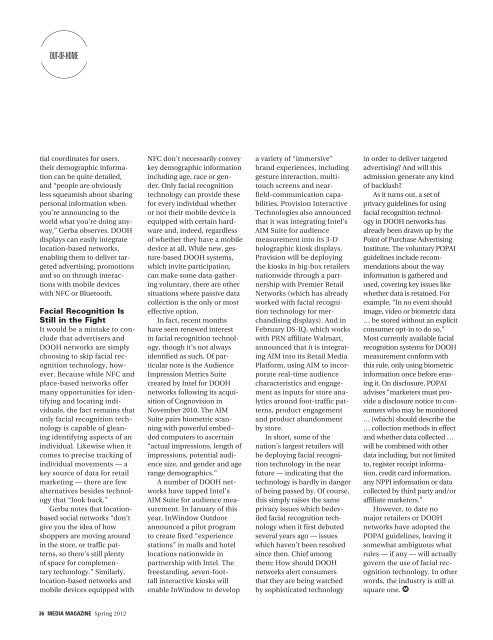THIRD ANNUAL SCREENS ISSUE - MediaPost
THIRD ANNUAL SCREENS ISSUE - MediaPost
THIRD ANNUAL SCREENS ISSUE - MediaPost
Create successful ePaper yourself
Turn your PDF publications into a flip-book with our unique Google optimized e-Paper software.
OUT-OF-HOME<br />
tial coordinates for users,<br />
their demographic information<br />
can be quite detailed,<br />
and “people are obviously<br />
less squeamish about sharing<br />
personal information when<br />
you’re announcing to the<br />
world what you’re doing anyway,”<br />
Gerba observes. DOOH<br />
displays can easily integrate<br />
location-based networks,<br />
enabling them to deliver targeted<br />
advertising, promotions<br />
and so on through interactions<br />
with mobile devices<br />
with NFC or Bluetooth.<br />
Facial Recognition Is<br />
Still in the Fight<br />
It would be a mistake to conclude<br />
that advertisers and<br />
DOOH networks are simply<br />
choosing to skip facial recognition<br />
technology, however.<br />
Because while NFC and<br />
place-based networks offer<br />
many opportunities for identifying<br />
and locating individuals,<br />
the fact remains that<br />
only facial recognition technology<br />
is capable of gleaning<br />
identifying aspects of an<br />
individual. Likewise when it<br />
comes to precise tracking of<br />
individual movements — a<br />
key source of data for retail<br />
marketing — there are few<br />
alternatives besides technology<br />
that “look back.”<br />
Gerba notes that locationbased<br />
social networks “don’t<br />
give you the idea of how<br />
shoppers are moving around<br />
in the store, or traffic patterns,<br />
so there’s still plenty<br />
of space for complementary<br />
technology.” Similarly,<br />
location-based networks and<br />
mobile devices equipped with<br />
36 MEDIA MAGAZINE Spring 2012<br />
NFC don’t necessarily convey<br />
key demographic information<br />
including age, race or gender.<br />
Only facial recognition<br />
technology can provide these<br />
for every individual whether<br />
or not their mobile device is<br />
equipped with certain hardware<br />
and, indeed, regardless<br />
of whether they have a mobile<br />
device at all. While new, gesture-based<br />
DOOH systems,<br />
which invite participation,<br />
can make some data-gathering<br />
voluntary, there are other<br />
situations where passive data<br />
collection is the only or most<br />
effective option.<br />
In fact, recent months<br />
have seen renewed interest<br />
in facial recognition technology,<br />
though it’s not always<br />
identified as such. Of particular<br />
note is the Audience<br />
Impression Metrics Suite<br />
created by Intel for DOOH<br />
networks following its acquisition<br />
of Cognovision in<br />
November 2010. The AIM<br />
Suite pairs biometric scanning<br />
with powerful embedded<br />
computers to ascertain<br />
“actual impressions, length of<br />
impressions, potential audience<br />
size, and gender and age<br />
range demographics.”<br />
A number of DOOH networks<br />
have tapped Intel’s<br />
AIM Suite for audience measurement.<br />
In January of this<br />
year, InWindow Outdoor<br />
announced a pilot program<br />
to create fixed “experience<br />
stations” in malls and hotel<br />
locations nationwide in<br />
partnership with Intel. The<br />
freestanding, seven-foottall<br />
interactive kiosks will<br />
enable InWindow to develop<br />
a variety of “immersive”<br />
brand experiences, including<br />
gesture interaction, multitouch<br />
screens and nearfield-communicationcapabilities.<br />
Provision Interactive<br />
Technologies also announced<br />
that it was integrating Intel’s<br />
AIM Suite for audience<br />
measurement into its 3-D<br />
holographic kiosk displays.<br />
Provision will be deploying<br />
the kiosks in big-box retailers<br />
nationwide through a partnership<br />
with Premier Retail<br />
Networks (which has already<br />
worked with facial recognition<br />
technology for merchandising<br />
displays). And in<br />
February DS-IQ, which works<br />
with PRN affiliate Walmart,<br />
announced that it is integrating<br />
AIM into its Retail Media<br />
Platform, using AIM to incorporate<br />
real-time audience<br />
characteristics and engagement<br />
as inputs for store analytics<br />
around foot-traffic patterns,<br />
product engagement<br />
and product abandonment<br />
by store.<br />
In short, some of the<br />
nation’s largest retailers will<br />
be deploying facial recognition<br />
technology in the near<br />
future — indicating that the<br />
technology is hardly in danger<br />
of being passed by. Of course,<br />
this simply raises the same<br />
privacy issues which bedeviled<br />
facial recognition technology<br />
when it first debuted<br />
several years ago — issues<br />
which haven’t been resolved<br />
since then. Chief among<br />
them: How should DOOH<br />
networks alert consumers<br />
that they are being watched<br />
by sophisticated technology<br />
in order to deliver targeted<br />
advertising? And will this<br />
admission generate any kind<br />
of backlash?<br />
As it turns out, a set of<br />
privacy guidelines for using<br />
facial recognition technology<br />
in DOOH networks has<br />
already been drawn up by the<br />
Point of Purchase Advertising<br />
Institute. The voluntary POPAI<br />
guidelines include recommendations<br />
about the way<br />
information is gathered and<br />
used, covering key issues like<br />
whether data is retained. For<br />
example, “In no event should<br />
image, video or biometric data<br />
… be stored without an explicit<br />
consumer opt-in to do so.”<br />
Most currently available facial<br />
recognition systems for DOOH<br />
measurement conform with<br />
this rule, only using biometric<br />
information once before erasing<br />
it. On disclosure, POPAI<br />
advises “marketers must provide<br />
a disclosure notice to consumers<br />
who may be monitored<br />
… [which] should describe the<br />
… collection methods in effect<br />
and whether data collected …<br />
will be combined with other<br />
data including, but not limited<br />
to, register receipt information,<br />
credit card information,<br />
any NPPI information or data<br />
collected by third party and/or<br />
affiliate marketers.”<br />
However, to date no<br />
major retailers or DOOH<br />
networks have adopted the<br />
POPAI guidelines, leaving it<br />
somewhat ambiguous what<br />
rules — if any — will actually<br />
govern the use of facial recognition<br />
technology. In other<br />
words, the industry is still at<br />
square one.








